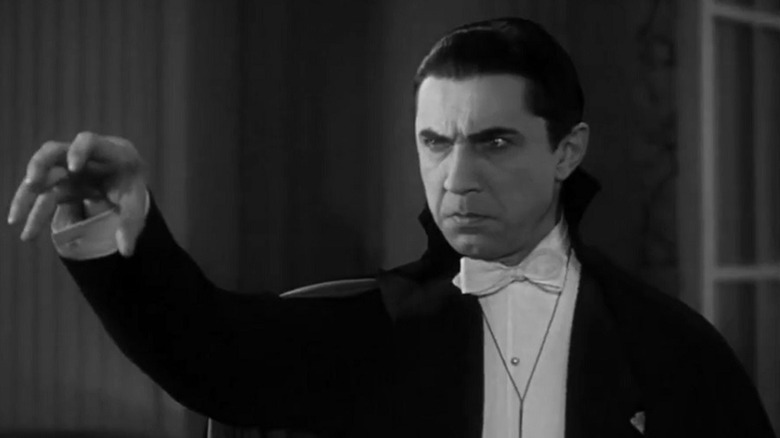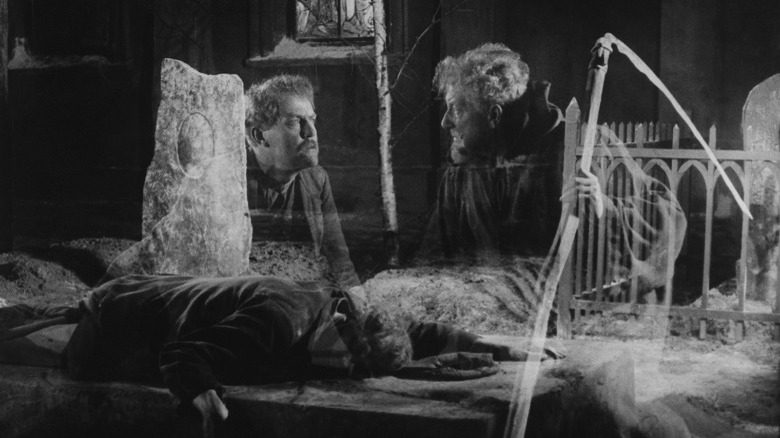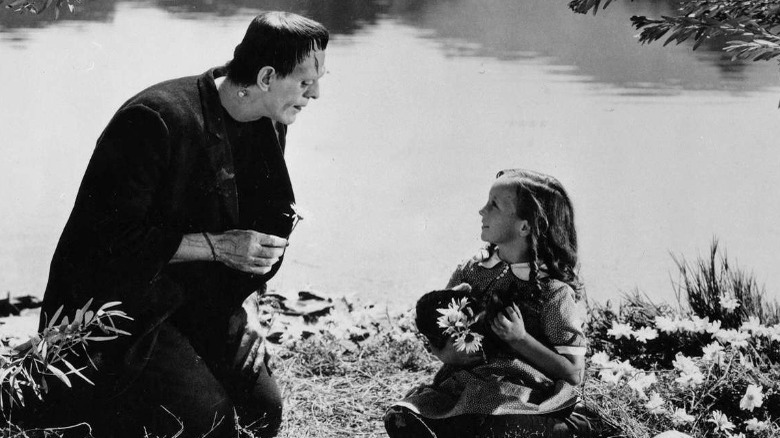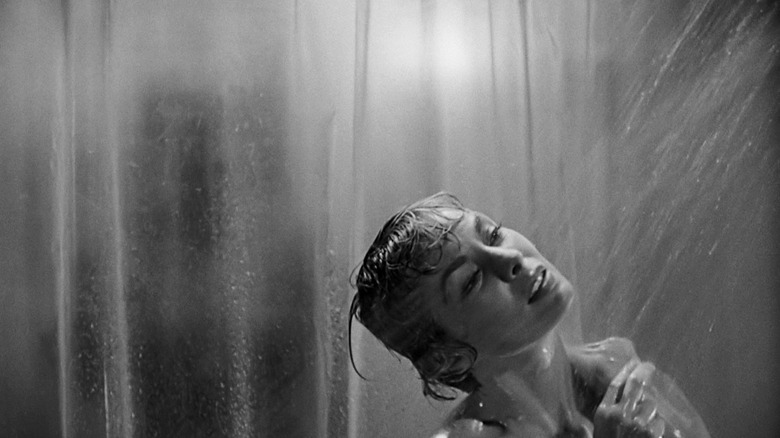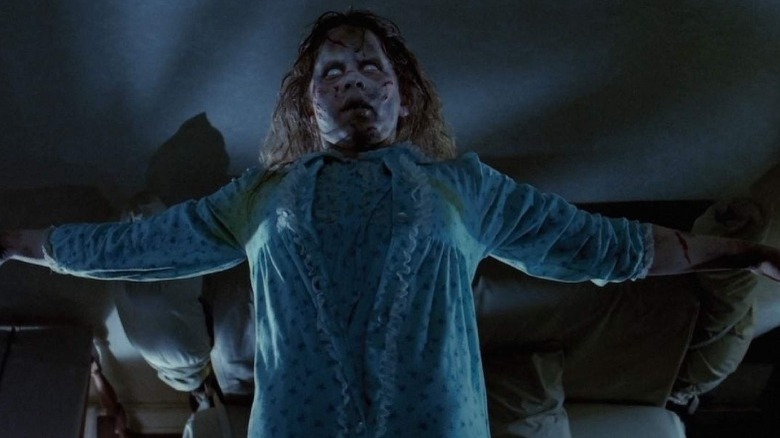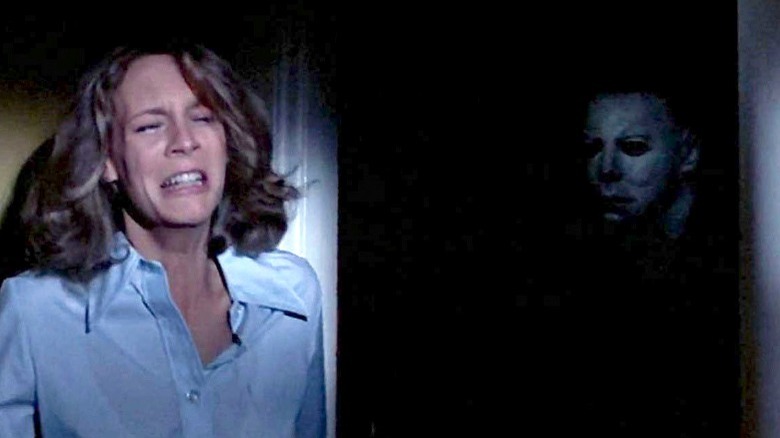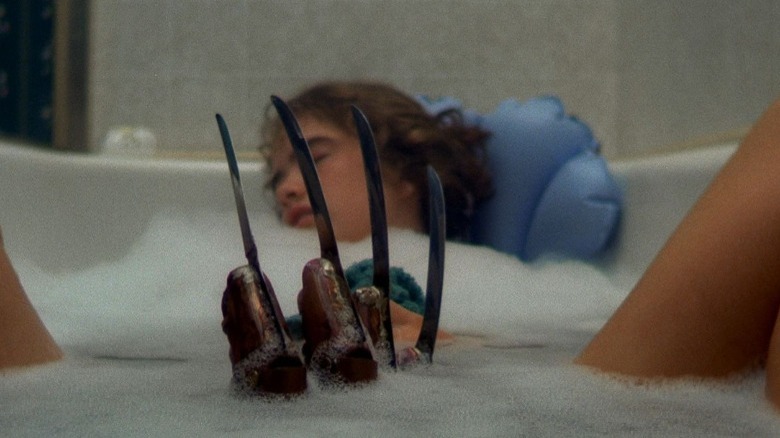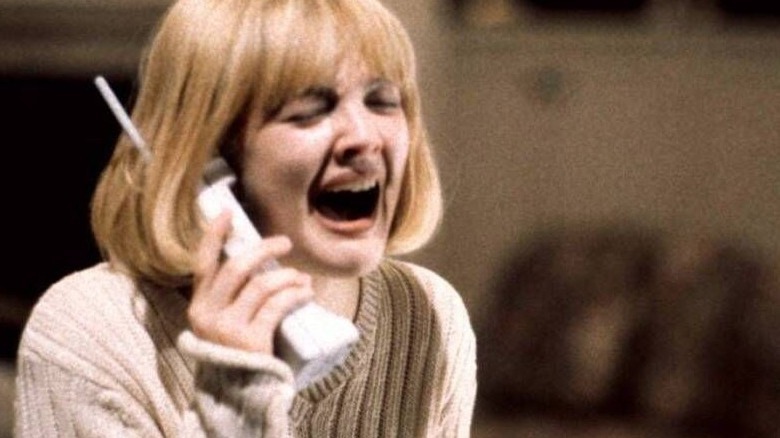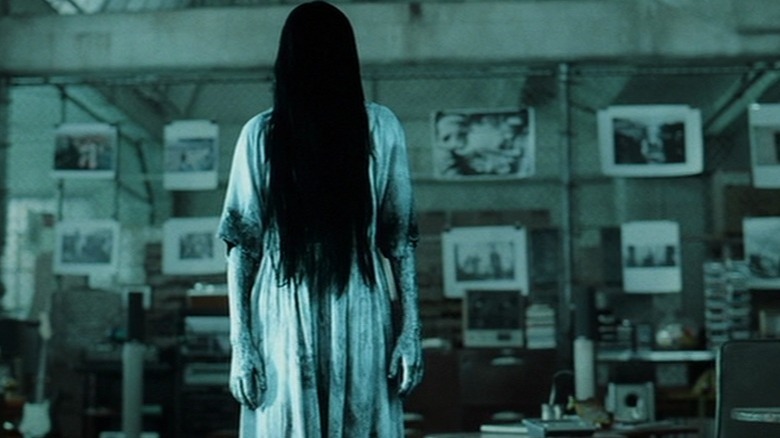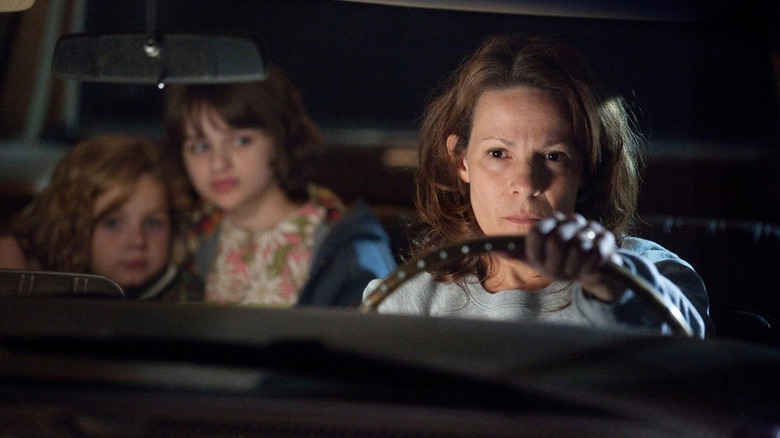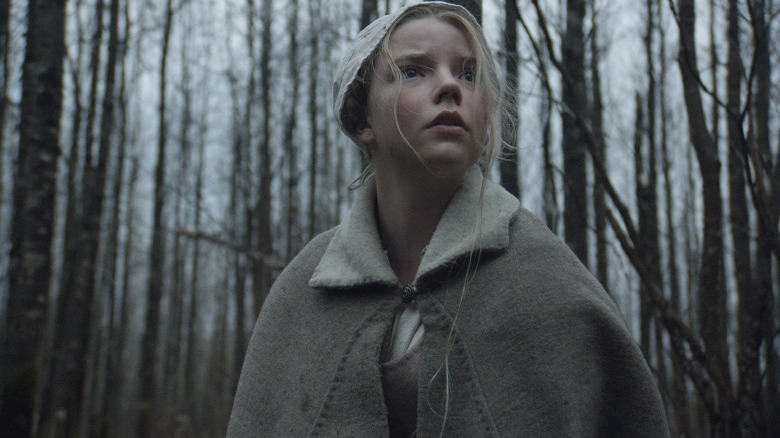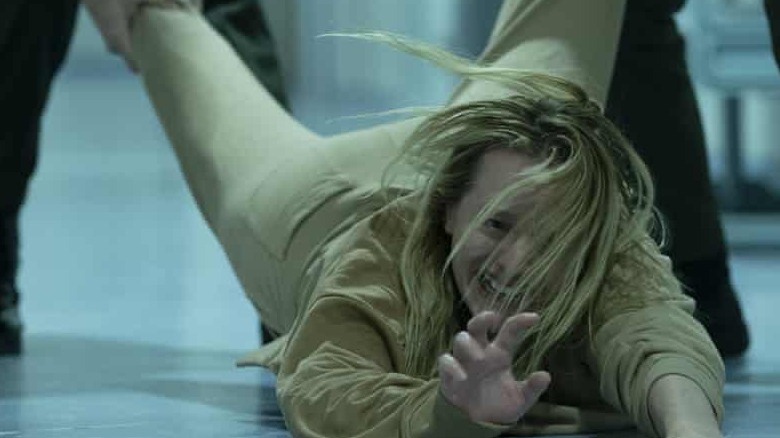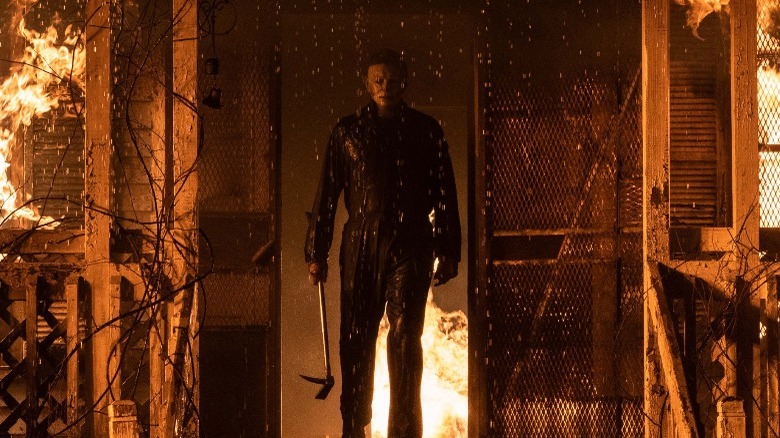The 12 Best Years In Horror Movies
There is a solid argument to be made that every year since 1897, when Georges Méliès' "Le Manoir du diable" (known in the United States as "The Haunted Castle") was released, could be considered the best year in horror movies. Credited by the University of Southern California as the first horror movie, Méliès' work set the template for what was to come. No longer limited to gothic novels and Grand Guignols, horror was and would be immensely cinematic.
Over a century later, horror continues to dominate. A deeply curative genre, one that refracts and interrogates humanity's common fears, horror is uniquely enduring as well as a perennially relevant genre. While there are shifts in form and narrative, the horror itself — shock and repulsion at something frightening — endures. Here we'll be counting down the 12 best years for horror movies, ranging from the early 1920s all the way to 2021. While these are certainly subjective, with every audience member having their own proclivities and desires, they represent some of the best of the best. These are the years that radically revamped the field, resulting in horror remaining the most consistently profitable film genre there is.
1. 1921
The year 1921 was the true boon of early horror. While there had been dabbles in the decades before, 1921 saw horror assume the cinematic form it most closely resembles now. There was verve and terror, a quasi-birth for a genre that was more than just a fluke. As media form shifted and cinema took off, so too did the horror genre as we know it now.
This year saw the release of Victor Sjöström's "The Phantom Carriage," a bonafide Criterion pick and one of the genre's best classic scarefests. It additionally saw the release of Friedrich Wilhelm Murnau's "The Haunted Castle" (no relation to Méliès' film). Murnau himself is a deeply influential horror director, one whose influence is still felt today. Other important features include "The Grinning Face" (aka "The Man Who Laughs") which was later remade in 1928 and inspired DC's The Joker, as well as "Dracula's Death," a lost film that remains a true point of interest among diehard horror fans. While the following year, 1922, saw the release of "Nosferatu," it would have never happened had it not been for what 1921 cultivated.
2. 1931
Auspiciously, 1931 was the birth of Universal's Classic Monsters series. With the release of Tod Browning's "Dracula," featuring a classic performance from Bela Lugosi, and James Whale's "Frankenstein," horror movie monsters were born. They were classic gothic tales adapted from seminal 19th-century works, movies that dominated and defined the cinematic landscape, titles still referenced and reworked today, as with André Øvredal's forthcoming "The Last Voyage of the Demeter."
More important still is how longstanding the Universal Monsters series has been. With remakes, reboots, and adaptations continuing to this day (some better than others), these movies have arguably endured better than any other filmic franchise. "Dracula," "Frankenstein," and later releases such as "The Mummy," "The Wolf Man," or "The Invisible Man," are classic movie monsters. Their contemporary counterparts are classics in their own right, clarifying the sheer legacy of these madmen and creatures. It seems that 1931 was the year that started it all. Horror wasn't just a genre anymore, it was exemplified by its terrifying titular monsters.
3. 1960
A turning point year, 1960 introduced Norman Bates and "Psycho" to the world. Alfred Hitchcock's low budget exercise was groundbreaking, a release that — alongside Michael Powell's "Peeping Tom" the same year — all but created the slasher genre. Both were deep explorations of a madman's psyche made while still skirting around the sensitivities of the '60s. Released two months apart, these films were unlike anything that had ever been seen before given the impact of their acts of violence, especially towards women. They were controversial ("Peeping Tom" ruined Powell's reputation in his native England), terrifying, and cultivated new directions for a genre that had been somewhat stuck in a land of giant monsters and insects throughout the Atomic '50s.
This year also saw the release of Georges Franju's "Eyes Without a Face," one of the scariest French horror movies ever made, now cemented as part of The Criterion Collection. Genre filmmaker and master showman William Castle really took off with the release of "13 Ghosts," shot with the gimmicky 3-D "Illusion-O" effect that gave audiences the choice of whether or not to see the titular specters. Plus, it saw not just one but two releases from horror god Roger Corman: "House of Usher," the first of his eight classic Edgar Allan Poe adaptations, as well as the cult comedy quickie "The Little Shop of Horrors" which later became a famed musical.
4. 1973
In 1973 we basked in the glory of several classic and worthwhile horror movies. Nicolas Roeg released "Don't Look Now," which features a classic sex scene between Donald Sutherland and Julie Christie, not to mention one of the most shocking endings ever. "Don't Be Afraid of the Dark" premiered on ABC, terrifying an entire at-home television audience with its tale of feisty, homicidal gremlins while also solidifying a Guillermo del Toro penned remake decades later. There was George Romero's "The Crazies" and John Hough's "The Legend of Hell House." It was a year of the eerie oddity "Messiah of Evil" and "Torso," a blood-soaked Giallo.
It was most importantly, however, the year of "The Exorcist," whose impact on the horror genre cannot be overstated. While its visceral nature has certainly been dulled in the years since release, it remains for many the scariest movie ever made. It was a critical darling, and a triumph for horror at the Academy Awards where it received 10 nominations (including Best Picture) and a screenplay win for William Peter Blatty. It was violent, graphic, and created an entire exorcism subgenre. Horror today isn't horror without "The Exorcist."
5. 1978
Imagine being a horror fan in 1978. I can hardly picture it without passing out from excitement. The idea of grabbing a few friends and going to my local theater to check out George Romero's "Dawn of the Dead" or Irvin Kershner's "The Eyes of Laura Mars" is intoxicating. It was an era before spoilers and social media, an era before aggressive marketing campaigns that condensed whole narrative arcs into two-minute spots to sell tickets. This year had Michael Chrichton's "Coma," still an undeservedly overlooked paranoid thriller, and it had Philip Kaufman's "Invasion of the Body Snatchers," the scariest sci-fi horror hybrid there is. It had sequels to "The Omen" and "Jaws," terrifying puppets in "Magic" and Joe Dante's "Piranha." It was a glorious year.
Most importantly, though, it saw the release of John Carpenter's "Halloween." Much like "The Exorcist," the impact of "Halloween" all but speaks for itself. Just as William Friedkin revolutionized horror five years before, Carpenter did it again. He cemented Michael Myers, the perennial boogeyman, in the collective consciousness. The decade of the slasher was born, and it was all thanks to Carpenter and the William Shatner mask that could.
6. 1984
There's no other way to put it: 1984 rocked. Just as the slasher boom was fizzling out — the same formula from John Carpenter's "Halloween" had been repeated ad nauseam, with marginal changes to setting or killer — Wes Craven came along to fix it. With "A Nightmare on Elm Street," the slasher subgenre was given new, supernatural life. Freddy Krueger became the colloquial dream killer, and Craven revitalized the horror genre with ingenious narrative control.
Yet 1984 wasn't just the year of "A Nightmare on Elm Street." It also saw the release of "The Initiation," a bonafide classic slasher and one of "Halloween's" best riffs. Additionally, Russell Mulcahy's grim outback thriller "Razorback" came out, a title still controversial to this day. There was "Gremlins," a Christmas horror classic, and "Friday the 13th: The Final Chapter," ostensibly the last entry in the long-running slasher saga. "Firestarter" and "Children of the Corn" helped solidify 1984 as the year of cult horror ... a year that freaking ruled.
7. 1996
Wes Craven was back to change the game all over again. In 1996, "Scream" revamped the formula he'd tried a year before with "Wes Craven's New Nightmare," a meta-riff on his own "A Nightmare on Elm Street." As the box-art so lovingly displayed, "Scream" was clever, hip, and scary. It changed the game, resulting in over a decade of self-aware meta-horror, a trend still seen to this day with the current trend of '80s throwbacks like "Fear Street." It remains a title that many horror fans rank at the top of their all-time lists. Horror for the remaining decade was incumbent on "Scream," and that's a legacy you can't shake a knife at.
Another stab at grunge horror was teen witch flick "The Craft," along with cult favorite werewolf movie "Bad Moon." Japanese horror took off with Hideo Nakata's "Don't Look Up," and Peter Jackson made horror fun again with "The Frighteners." Add in "Thinner" and "From Dusk Till Dawn" and we all have to agree it was a game-changing year, one whose influence remained all the way until 2002.
8. 2002
The influence "Scream" had never really stopped as there is, after all, a sequel on the way, but 2002 was the year horror did away with self-aware fun and started getting really, really serious. Domestically, this was largely on account of 9/11 and the horror renaissance that followed. Tragedy always incites new directions, and 2002 was no different. There was Gore Verbinski's "The Ring" remake, a terrifying condemnation of technology that also spurred the trend of horror imports. Danny Boyle's "28 Days Later" was a radical revamp of the zombie subgenre, replacing slow flesh-eating baddies with the quick-footed rage virus infected. It was deeply political and thoroughly terrifying.
More than anything, the genre was testing out new directions. While there was still some familiarity, it was a year that mandated change. The horror of the past wouldn't cut it in the new world. "Dark Water" and "Dog Soldiers" released overseas, demonstrating the global shift in horror directions, and domestically, "Ghost Ship" and "Halloween: Resurrection" all but signaled the end to the horror of the nineties. Also the over four-hour-long ABC miniseries "Rose Red" gave us arguably one of the best Stephen King adaptations.
9. 2013
Just as 2002 signaled the end of an era and the start of new directions, so too did 2013. Horror had been stagnating with a deluge of remakes, teen fare, and frustratingly dull releases, especially on the theatrical side. There had been some gems in the years between 2002 and 2013 with the "torture porn" and extremity phenomenon, but mainstream horror had lulled. A jolt to the genre, 2013 was a wake-up call that reinvigorated audiences and gave them good reason to be scared again.
Chucky the killer doll returned after a long hiatus in "Curse of Chucky," and "Evil Dead" cemented itself as one of the best horror remakes ever made. There was "Mama," a movie that jump-started "It" director Andres Muschietti's career, and Bobcat Goldthwait's "Willow Creek," 2013's answer to "The Blair Witch Project." Most importantly, though, it saw the release of James Wan's "The Conjuring," a movie whose influence is no different than "Scream" or "The Exorcist." In a sense, "The Conjuring" is still the template for contemporary horror, especially considering the success and longevity of its cinematic universe. Haunted houses were back, a radical shift from the extreme horror of the early aughts, and they were scarier than ever.
10. 2015
The year 2015 was a quasi-rebirth for the genre. With "The Gallows" and "Insidious: Chapter 3," among others, the impact of "The Conjuring" still reigned supreme. Yet, it was also the year of true independent horror, a trend that continues to dominate today. As streaming accessibility increased and theaters started showing weirder, stranger horror, the landscape expanded. Once limited to just the genre juggernauts, now the theatrical realm gave us everything in-between.
"The Witch" signaled that A24's unique brand of horror was born, and with "The Final Girls" indie love-letters excelled. There was "Krampus," a contemporary cult-classic that exceeded expectations, while "The Invitation" and its dinner party from Hell still captivates intrepid audience members when they stumble across it streaming somewhere. Guillermo del Toro released "Crimson Peak," a sort of gothic opus emblematic of his unique gifts, and "The Visit" reignited M. Night Shyamalan's career after a series of flops. It wasn't the most groundbreaking year, but it was quietly critical for the development of the genre.
11. 2020
Horror saved 2020 because... well, it did. With the release of "The Vast of Night" and "The Dark and the Wicked," indie horror was exceptionally comforting in a year of stalled productions, shuttered theaters, and delayed releases. Due to COVID issues, The Pierce Brothers' tiny indie "The Wretched" became the first film since "Avatar" to take the top spot at the box office for five consecutive weeks. It was an unconventional year, yes, but horror — as horror is wont to do — survived. In fact, it didn't just survive, it thrived.
"Relic" remains one of the scariest, yet deeply human, horror stories ever told. "Hunter Hunter" dominated the Twitter-sphere with its shocking final twist and knifes-edge tension throughout. "The Invisible Man," one of 2020's last theatrical releases, captivated audiences, and bonafide classic "The Empty Man" had its quiet theatrical release in October 2020 (which was an admittedly bad move, but I digress). Horror was truly the one genre that could not just withstand a pandemic, but help audiences heal from it. Horror really did save 2020.
12. 2021
This might seem a controversial entry, largely because the year is so recent. In the great pantheon of core years for the development of horror, it can be difficult to list the most recent as having been a key player. Yet, 2020 and 2021, in a sense, are symbiotic: Without one, the other couldn't exist. The year 2021 qualifies on account of both 2020 and how staggeringly remunerative the genre was this past year. While exhibitors and analysts worried about the viability of theatrical showings, horror reminded them their fears were for naught.
"Halloween Kills," in spite of a day-and-date release on Peacock, opened to almost $50 million. Nia DaCosta's "Candyman" quietly ignited the late summer box office. It was a year of returning icons, and not just Candyman and Michael Myers. We also got the terrifying creatures of "A Quiet Place: Part II" and more "Conjuring Universe" fun in "The Conjuring: The Devil Made Me Do It." All of them were holdovers from 2020, yes, but in a year so desperate for cinematic success, horror asked the industry to simply hold its beer. It was going to all work out.
